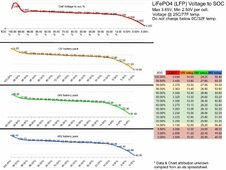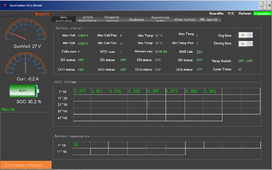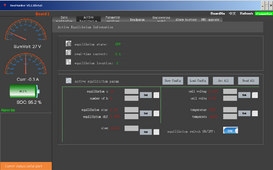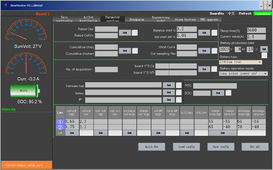100degrees
New Member
Setup: MN3024DIY plugged into the grid -> Daly BMS (8S running 2P at the moment) -> LEV60F LFP cells @ 28V collectively (3.5V per cell.)
I noticed that my bank would discharge down to 26.9V and then charge up again to 28V and repeat that process several times a day. Based on what I've learned here there are several possible causes of that lost energy: the batteries could be self discharging, the Daly could be misbehaving or the Chinese Midnite branded charge controller could be doing something odd. Since I'm still building my battery capacity tester, and haven't fully figured out how to use the badly translated Daly UART interface beyond making sure that it's basic cell voltage and balance settings look right, I started with the MN3024DIY.
I got connected to the Daly UART interface and saw that it reported a ~.3 amp power draw with the MN3024DIY plugged into the wall. On charge, amperage readings on the Daly match up with what the Midnite is set to charge at so I think it's fairly accurate. Then I disconnected the negative lead of the battery bank from the MN3024DIY. Amperage dropped to nothing, which doesn't really tell me much other than the Daly isn't discharging .3 amps through the tiny monitoring wires used for balancing since disconnecting the negative lead created an open circuit. The battery voltage did stop dropping though so the cause of my lost power isn't the Daly balancing circuit but something on the main load.
My assumptions are that the MN3024DIY shouldn't be drawing power from the battery bank when connected to the grid. Also, the Daly BMS is supposed to draw about 100uA during normal operation. Am I right or wrong to think that neither of these loads should be pulling 8 watts an hour?
I have a killowatt meter, if that can do a running read of consumed power maybe I can figure out how much power the combined system is running through in a day, then if I deduct the expected power draw I can at least find out how much power this thing is wasting.
Any thoughts on how I should go about troubleshooting this? Anticipating one of them: I'm poor, this is what I can afford, buying better stuff isn't an option available to me. If it were everything I own would probably be blue.
I noticed that my bank would discharge down to 26.9V and then charge up again to 28V and repeat that process several times a day. Based on what I've learned here there are several possible causes of that lost energy: the batteries could be self discharging, the Daly could be misbehaving or the Chinese Midnite branded charge controller could be doing something odd. Since I'm still building my battery capacity tester, and haven't fully figured out how to use the badly translated Daly UART interface beyond making sure that it's basic cell voltage and balance settings look right, I started with the MN3024DIY.
I got connected to the Daly UART interface and saw that it reported a ~.3 amp power draw with the MN3024DIY plugged into the wall. On charge, amperage readings on the Daly match up with what the Midnite is set to charge at so I think it's fairly accurate. Then I disconnected the negative lead of the battery bank from the MN3024DIY. Amperage dropped to nothing, which doesn't really tell me much other than the Daly isn't discharging .3 amps through the tiny monitoring wires used for balancing since disconnecting the negative lead created an open circuit. The battery voltage did stop dropping though so the cause of my lost power isn't the Daly balancing circuit but something on the main load.
My assumptions are that the MN3024DIY shouldn't be drawing power from the battery bank when connected to the grid. Also, the Daly BMS is supposed to draw about 100uA during normal operation. Am I right or wrong to think that neither of these loads should be pulling 8 watts an hour?
I have a killowatt meter, if that can do a running read of consumed power maybe I can figure out how much power the combined system is running through in a day, then if I deduct the expected power draw I can at least find out how much power this thing is wasting.
Any thoughts on how I should go about troubleshooting this? Anticipating one of them: I'm poor, this is what I can afford, buying better stuff isn't an option available to me. If it were everything I own would probably be blue.








